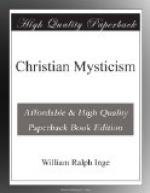Thus Eckhart is not content with the knowledge of God which is mediated by Christ, but aspires to penetrate into the “Divine darkness” which underlies the manifestation of the Trinity. In fact, when he speaks of the imitation of Christ, he distinguishes between “the way of the manhood,” which has to be followed by all, and “the way of the Godhead,” which is for the mystic only. In this overbold aspiration to rise “from the Three to the One,” he falls into the error which we have already noticed, and several passages in his writings advocate the quietistic self-simplification which belongs to this scheme of perfection. There are sentences in which he exhorts us to strip off all that comes to us from the senses, and to throw ourselves upon the heart of God, there to rest for ever, “hidden from all creatures[251].” But there are many other passages of an opposite tendency. He tells us that “the way of the manhood,” which, of course, includes imitation of the active life of Christ, must be trodden first by all; he insists that in the state of union the faculties of the soul will act in a new and higher way, so that the personality is restored, not destroyed; and, lastly, he teaches that contemplation is only the means to a higher activity, and that this is, in fact, its object; “what a man has taken in by contemplation, that he pours out in love.” There is no contradiction in the desire for rest combined with the desire for active service; for rest can only be defined as unimpeded activity; but in Eckhart there is, I think, a real inconsistency. The traditions of his philosophy pointed towards withdrawal from the world and from outward occupations—towards the monkish ideal, in a word; but the modern spirit was already astir within him. He preached in German to the general public, and his favourite themes are the present living operation of the Spirit, and the consecration of life in the world. There is, he shows, no contradiction between the active and the contemplative life; the former belongs to the faculties of the soul, the latter to its essence. In commenting on the story of Martha and Mary, those favourite types of activity and contemplation[252], he surprises us by putting Martha first. “Mary hath chosen the good part; that is,” he says, “she is striving to be as holy as her sister. Mary is still at school: Martha has learnt her lesson. It is better to feed the hungry than to see even such visions as St. Paul saw.” “Besser ein Lebemeister als tausend Lesemeister.” He discourages monkish religiosity and external badges of saintliness—“avoid everything peculiar,” he says, “in dress, food, and language.” “You need not go into a desert and fast; a crowd is often more lonely than a wilderness, and small things harder to do than great.” “What is the good of the dead bones of saints?” he asks, in the spirit of a sixteenth century reformer; “the dead can neither give nor take[253].” This double aspect of Eckhart’s teaching makes him particularly interesting; he seems to stand on the dividing-line between mediaeval and modern Christianity.




